A Step By Step Guide To Running A Keyword Competitive Analysis


By The BBS Agency
December 8, 2021
EDITOR’S NOTE: Keyword competitive analysis is the process of finding relevant and valuable keywords that your competitors rank for, but you don’t. If your competitors are targeting relevant keywords and getting traffic from them, then they’re likely highly relevant to your business, too. There are a few steps to completing your keyword competitive analysis. First and foremost, find your competitors. Next you’ll want to use Ahref’s content gap tool to find keywords that other websites rank for, but you don’t. Determine which of these keywords are valuable for your business and assess their ranking difficulty. You could also do a competitive keyword analysis on specific pages on your website. This can be used to target more long tail keywords or rank higher for your focus keyphrase. All in all we definitely recommend completing a competitive keyword analysis from time to time in order to find new keywords and topics you may have missed. If this all sounds overwhelming, feel free to reach out to us at The BBS Agency and we’d love to help out!
Although that might sound like a negative, it can be a positive.
If your competitors have done keyword research and found topics that you missed, they’ve done the hard work for you. You can find new and valuable keywords just by running a competitive keyword analysis.
Here’s what you’ll learn in this post:
- What is keyword competitive analysis?
- Why should you do one?
- How to do a competitor keyword analysis
Keyword competitive analysis is the process of finding relevant and valuable keywords that your competitors rank for, but you don’t.
If your competitors are targeting relevant keywords and getting traffic from them, then they’re likely highly relevant to your business, too.
The keyword competitive analysis process is roughly the same whether you’re looking for new topics to cover or gaps in existing content.
In this section, we’ll focus on uncovering new topics.
(Jump to the next section if you want to find gaps in existing content).
1. Find competitors
Even if you already have an idea who your business competitors are, it’s important to know that business competitors aren’t always the same as your search competitors. When looking for relevant and valuable topics to cover, it’s better to analyze the latter.
To illustrate the difference between business and search competitors, consider us and backlinko.com. We make money selling SEO tools whereas Brian Dean, the founder of Backlinko, makes money selling SEO courses. Although he’s not our direct business competitor, we’re competing for many of the same keywords because we’re fighting for the same audience.
Let’s look at three simple ways to find online competitors.
a) Run a Google ‘related’ search
The related: Google search operator finds websites related to yours. Just search for related:yourwebsite.com

Photo: Ahrefs
It’s fine to use a subfolder or subdomain if you’re looking for competitors for a particular part of your website like a blog.
Note that this method can be a bit hit and miss. If your site is quite new and doesn’t yet rank for many keywords, you might only see a few search results. Either way, make sure to check the sites manually before moving on to the next step. If they don’t look like competitors, ignore them.
b) Find websites with overlapping keywords
Plug your website into Ahrefs’ Site Explorer and go to the Competing Domains report. Each website in the report ranks in the top 10 for some of the same keywords as you, with those near the top having more overlap.
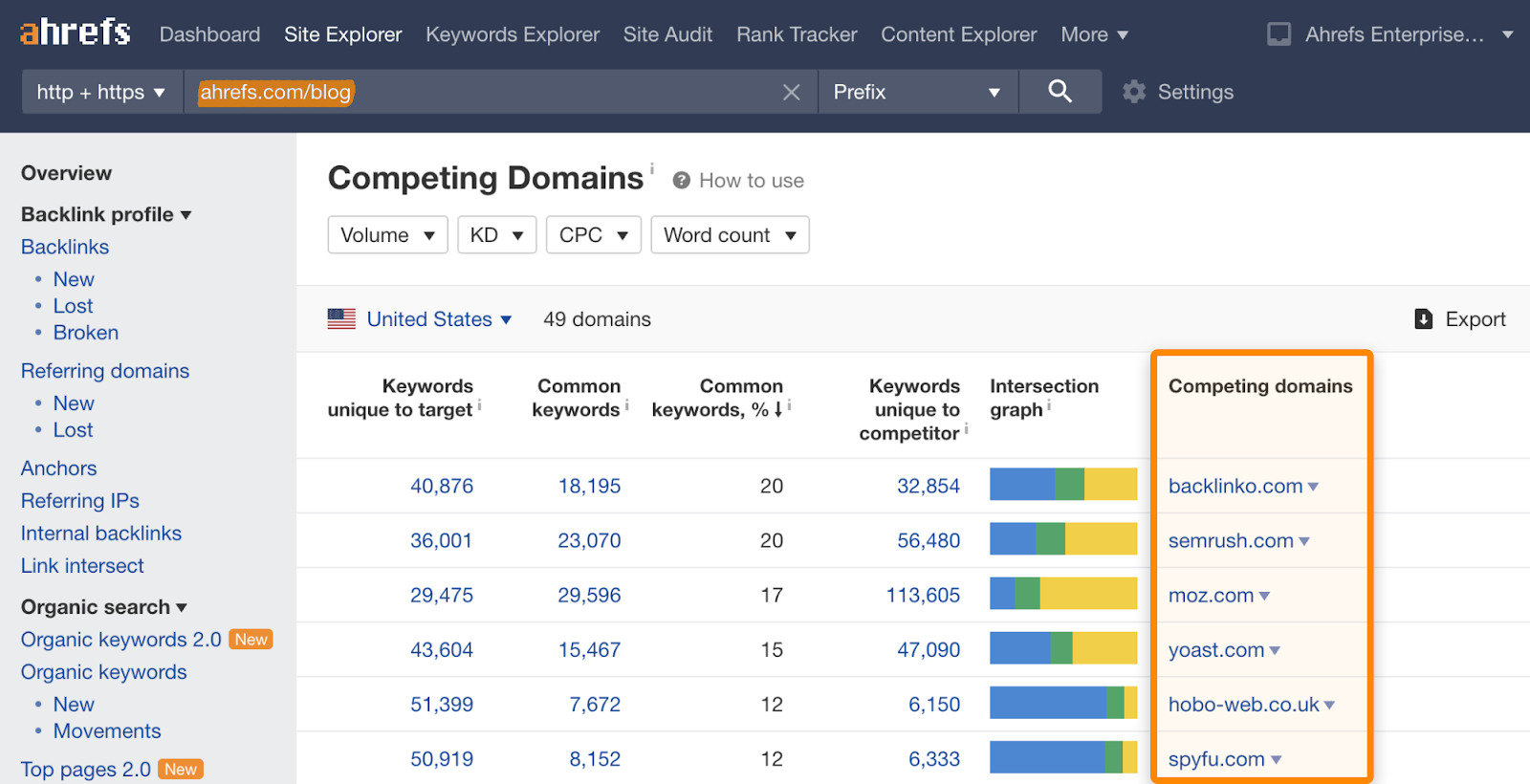
Photo: Ahrefs
Note that this won’t work particularly well if your site is new and doesn’t rank for many keywords because it looks for common keywords. There can’t be overlapping keywords if you don’t rank for anything.
c) Find sites ranking for valuable keywords
If none of the methods above give relevant results, plug a few relevant and valuable keywords into Ahrefs’ Keywords Explorer and check the Traffic Share by Domains report. This finds the websites with the most estimated organic traffic from the searched keywords.
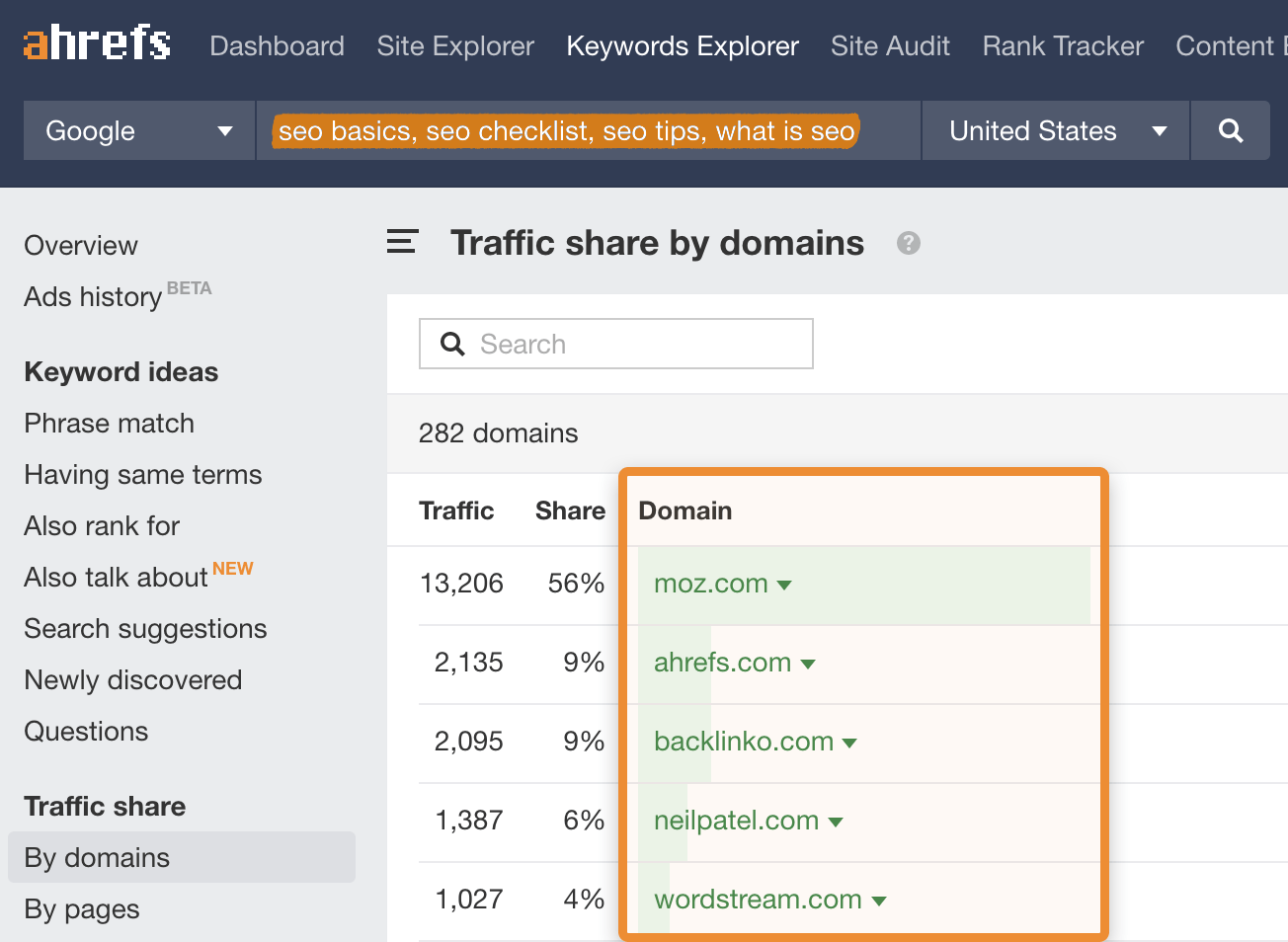
Photo: Ahrefs
Using this method is the best approach if:
- Your website doesn’t rank for many keywords yet
- You’re looking for competitors for specific topics
For example, because our blog content is mostly about SEO, the methods above tend to surface other SEO blogs. That’s fine if we want to find gaps in our SEO content, but we’ve recently started to cover other topics like content marketing and blogging. To find competitors for these topics, we could plug keywords like ‘content marketing,’ ‘content strategy,’ and ‘editorial calendar’ into Keywords Explorer and check which websites get the most search traffic.

Photo: Ahrefs
2. Use a content gap tool
Content gap tools find keywords that other websites rank for, but you don’t. Most of the big SEO tools have one but as you’re reading the Ahrefs Blog, we’ll demonstrate with ours.
Here’s the process:
- Plug your website into Ahrefs’ Site Explorer and go to the Content Gap tool.
- Enter your competitors’ below where it says “Show keywords that the below targets rank for.”
- Hit “Show keywords” to see the results.

Photo: Ahrefs
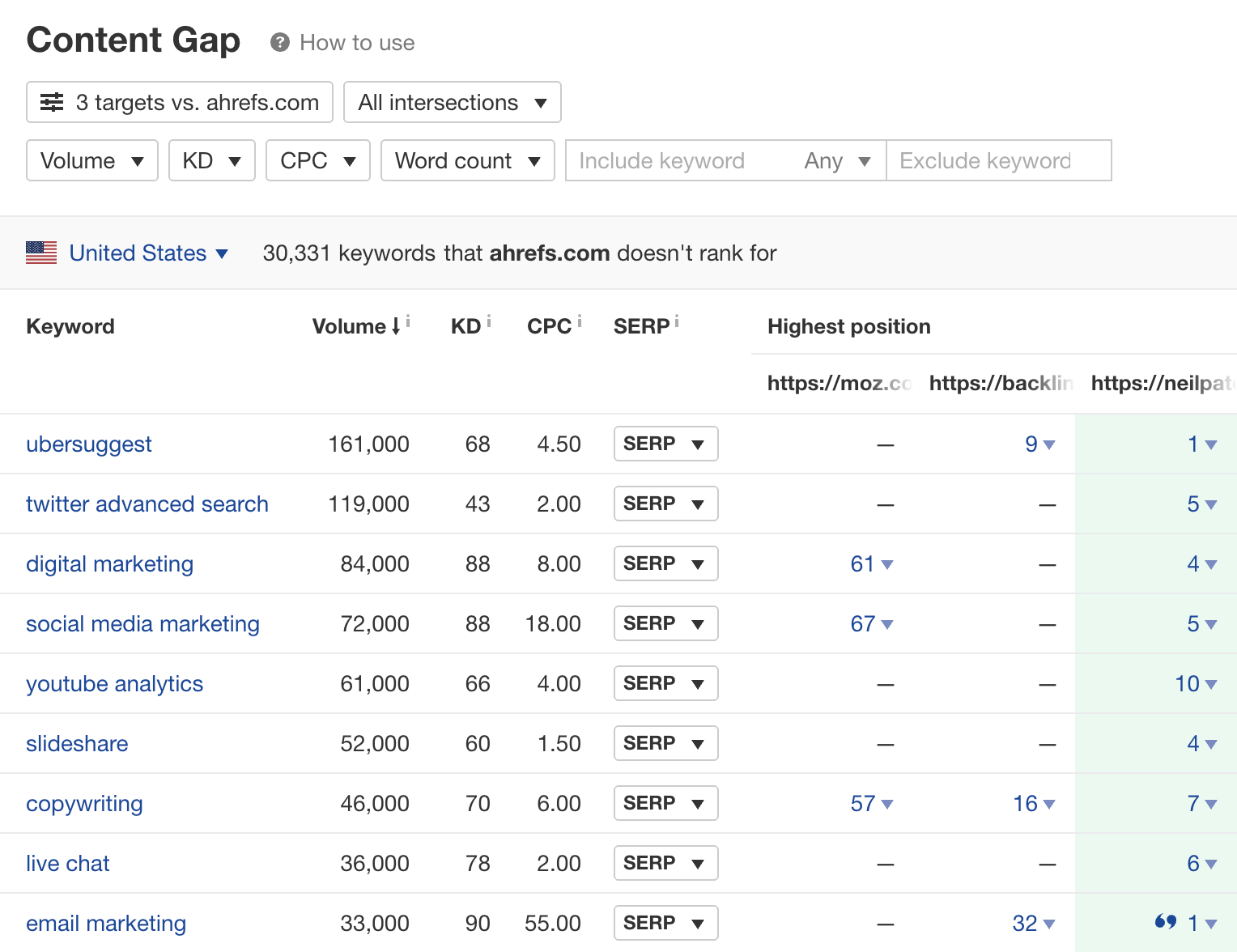 Photo: Ahrefs
Photo: AhrefsIf there are too many keywords to sift through or they look mostly irrelevant, play around with the number of intersections to see keywords that only a certain number of competitors rank for.

Photo: Ahrefs
If you only want to see keywords that competitors rank for with a particular section of their website, enter a subdomain or subfolder instead. For example, if we were running a keyword competition analysis for the Ahrefs Blog, we might plug in competitors like Backlinko and Moz. But as we’re only interested in blog content, we’d want to analyze moz.com/blog instead of moz.com as all of their blog post URLs include that prefix.

Photo: Ahrefs
3. Look for valuable topics
It’s unlikely that you’ll want to rank for everything your competitors are ranking for. Here are three things to consider when choosing keywords.
a) Business value
Business value is a score we created that represents the “value” a keyword has to a business. It’s ultimately a judgement call. Just ask yourself how likely searchers are to want to buy what you sell. The more likely this is, the higher the ‘business value’ of the keyword.
For example, if you sell computer parts, the ‘business value’ of the keyword ‘buy 1tb hard drive’ will probably be quite high. On the flipside, it’ll be quite low for ‘what is a computer’ as people searching for that are unlikely to want to build their own computer anytime soon.
At Ahrefs, we assign keywords a business value between 0–3 to keep things simple.
b) Search volume
Search volume is the average number of monthly searches for a keyword. As a general rule, the higher a keyword’s search volume, the higher the traffic potential of the topic. In the Content Gap report, there’s a column for search volume next to the keyword.

Photo: Ahrefs
c) Organic traffic potential
Take a look at the search volume for this keyword vs. estimated traffic to the top-ranking page:
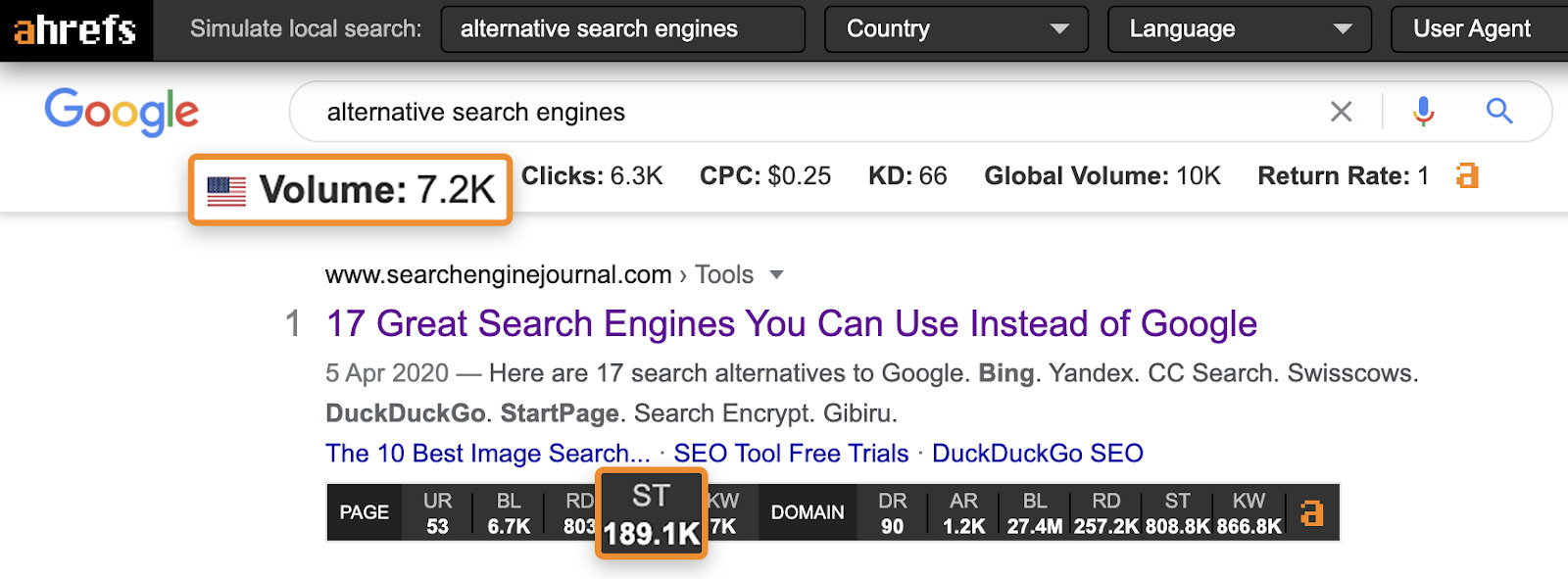
Photo: Ahrefs
Even though the keyword only gets 7.2K searches per month, the top page is getting roughly 25x more organic traffic. That’s because it’s ranking thousands of other related keywords, otherwise known as long-tail keywords. Many of these are just less popular ways of searching for the same thing.
Looking at traffic to the top-ranking pages is a far more reliable way to judge the traffic potential of a keyword than search volume. We recommend to always check this before making the final decision whether to go after a keyword.
To do this in the Content Gap tool, just hit the SERP button and check the traffic column.

Photo: Ahrefs
4. Assess ranking difficulty
It’s not always easy to rank for the same things as competitors. There are many reasons why they might find it easier to rank for a keyword than you. So before you jump into targeting a keyword, you should always assess ranking difficulty.
The Keyword Difficulty (KD) metric in Ahrefs is enough to give you a very rough sense of ranking difficulty. You can see this in the Content Gap report.

Photo: Ahrefs
But you shouldn’t judge ranking difficulty on any tools’ keyword difficulty metric alone.
Here are three other things to take into account:
1. Search intent
Search intent is the reason why people are searching for a keyword.
- Are they looking for information?
- Do they want to buy something?
- Are they looking for a particular website?
If your content doesn’t align with search intent, your chances of ranking are slim to none.
Google understands intent better than anyone so the top-ranking pages are a great proxy to search intent.
For example, all the results for “speed up windows 10” are list-style blog posts, whereas for “corsair k70” they’re all product pages from ecommerce stores.

Results for “speed up windows 10” are all listicles.
 Photo: Ahrefs
Photo: Ahrefs
Results for “corsair k70” are all product pages.
Just know that unless there’s value in you publishing the type of content that aligns with search intent, there isn’t much point in targeting a keyword. For example, if you run a computing blog, there’s not much point targeting a keyword like “corsair k70” because searchers are in buying mode. There’s no way to satisfy intent without a product page, which a blog won’t have.
Recommended reading: What is Search Intent? A Complete Guide for Beginners
2. Website authority
Google’s John Mueller has publicly stated that they don’t use any kind of website authority metric in their ranking algorithms.
However, industry professionals are divided on this issue—with some believing that Google isn’t being entirely truthful. It’s certainly easy to see why when the search results for some keywords are dominated almost exclusively by household brands.
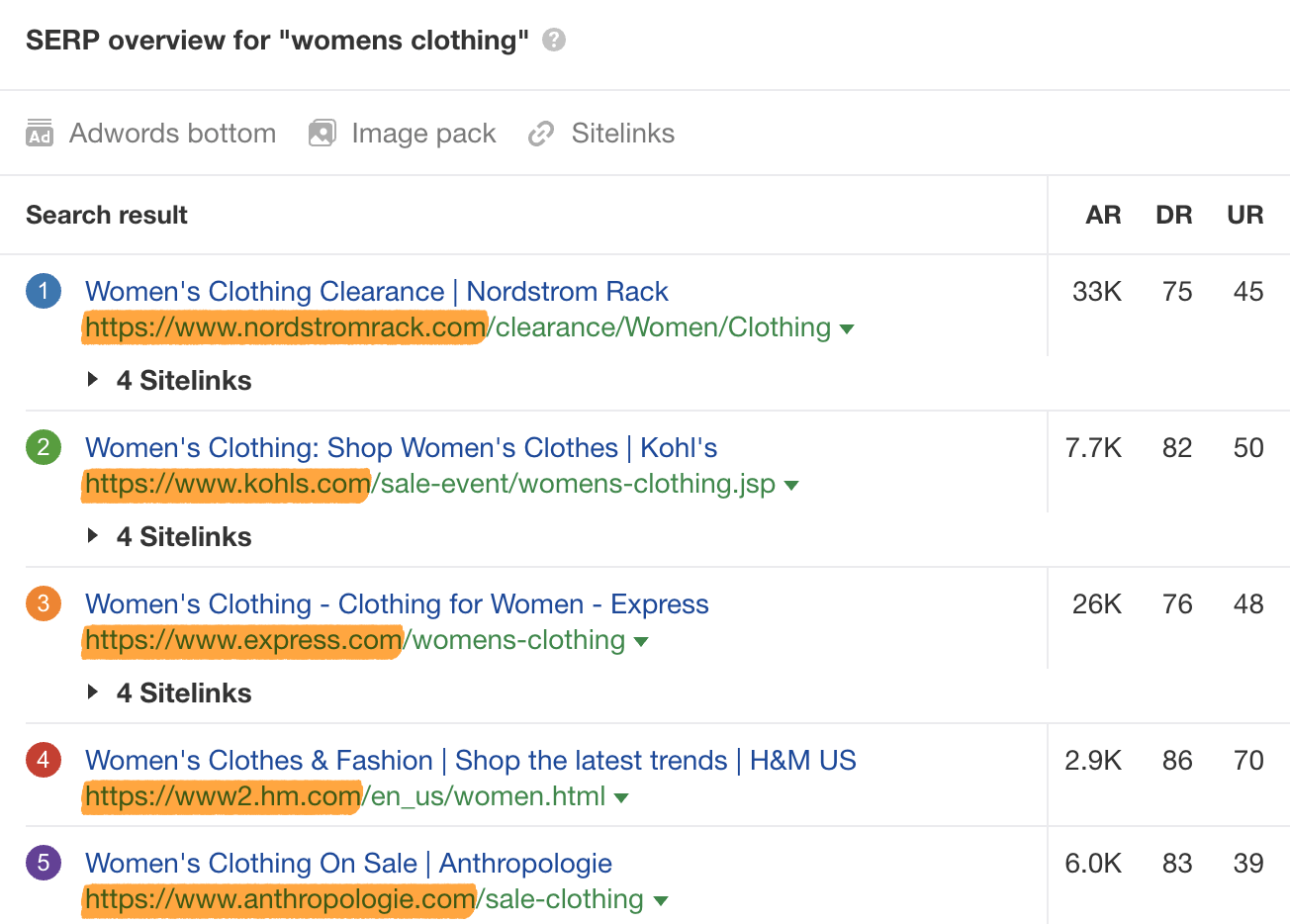
Photo: Ahrefs
In Ahrefs, we have a metric called Domain Rating (DR) that represents a website’s authority based on the strength of its backlink profile. This isn’t factored into our KD score, but, as a general rule, you might find it hard to rank if the top results for a keyword come from sites with wildly higher DR scores than yours.
You can see the DR of all top-ranking sites in the SERP overview.
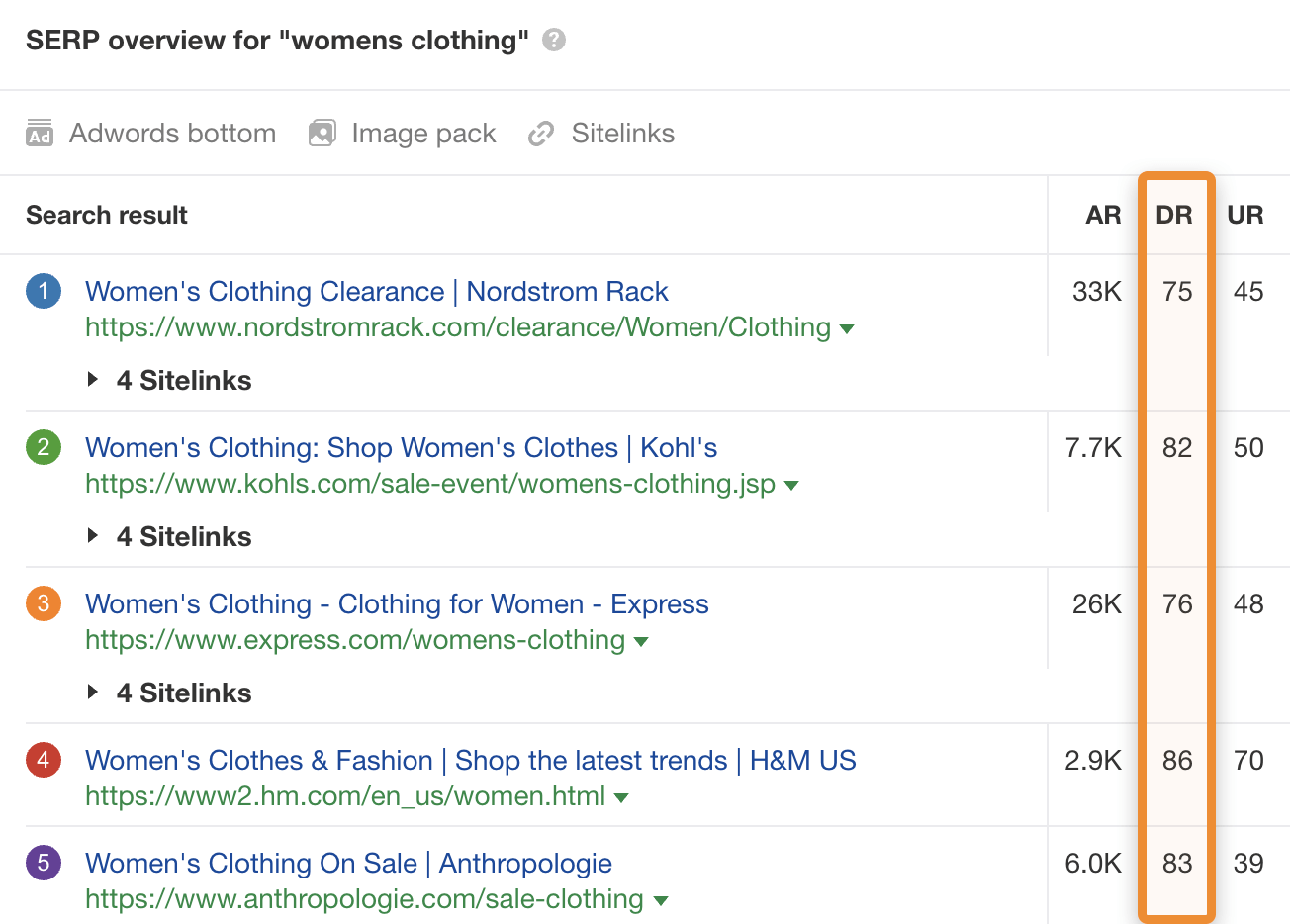
Photo: Ahrefs
You can see your website’s DR in Site Explorer, or by using our free website authority checker.
Recommended reading: How to Increase Website Authority (Domain Rating)
3. High-quality links from other websites
Backlinks are a known ranking factor.
Keyword Difficulty (KD) takes the quantity of links to the top-ranking pages into account, but not their quality. So it’s worth checking the backlink profiles of the top-ranking pages before targeting a keyword. You’ll often find that although a page has lots of websites linking to it, many are low-quality—in which case it might be easier to outrank the page than you initially thought.
For example, look at the first couple of results for “best home printer”—which has a KD score of 60:
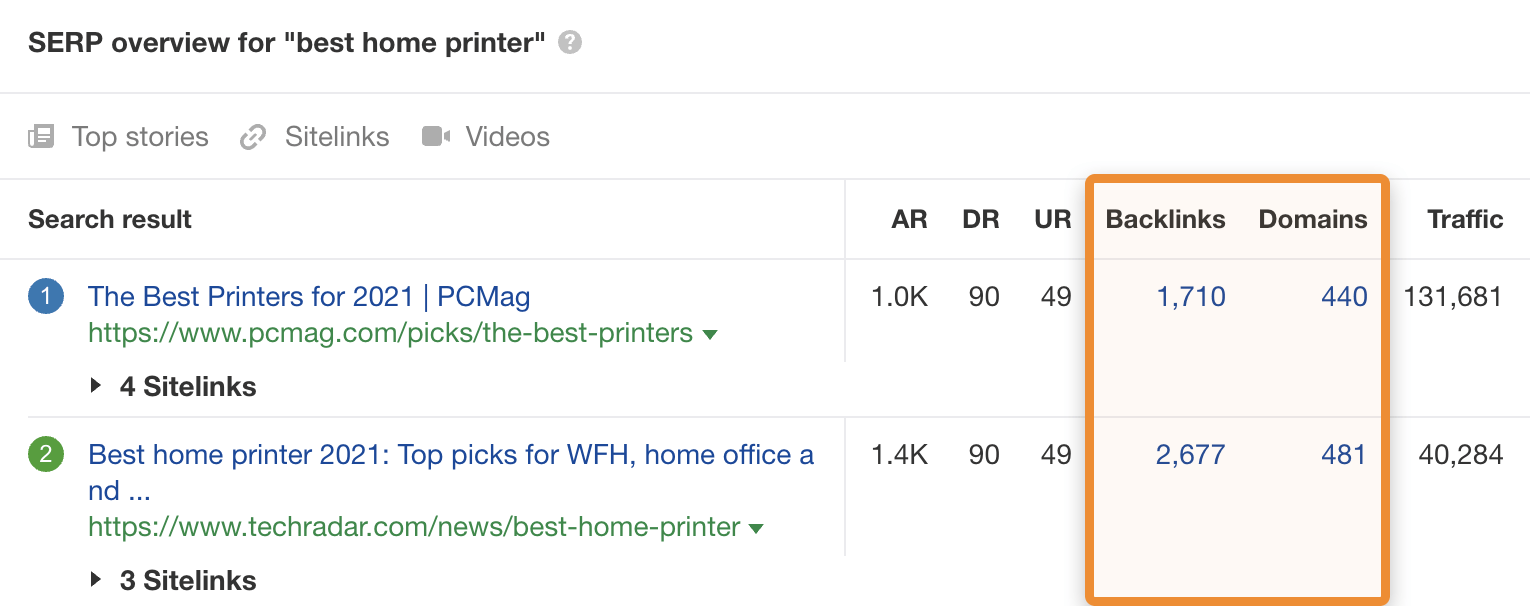
Photo: Ahrefs
It initially looks like quite a hard keyword to crack because the top-ranking page has links from lots of websites. But if we check its backlinks in Ahrefs’ Site Explorer, most of them are low-quality and nofollowed.
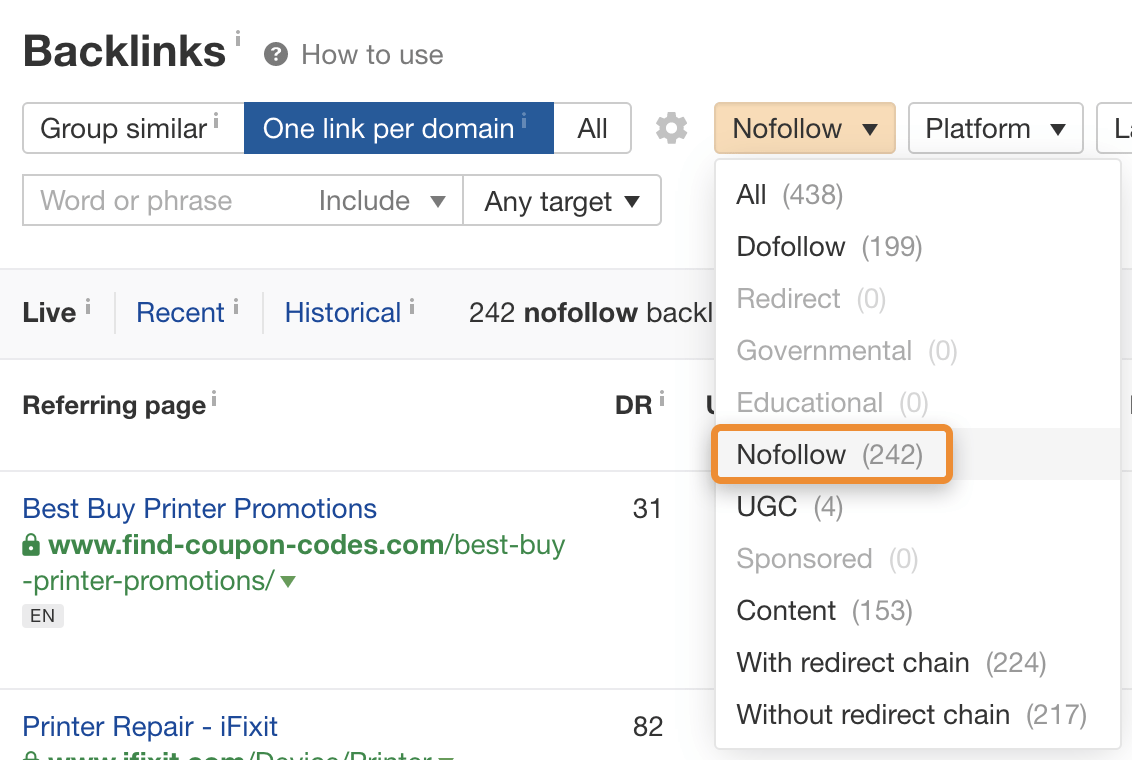
Photo: Ahrefs
If you can match search intent and your website is authoritative enough, you probably won’t need that many high-quality links to outrank this page.
Even if ranking for a keyword seems difficult, that doesn’t mean you shouldn’t be targeting it. You just need to be realistic and divide keywords into long, medium, and short-term targets.
How to do a page-level keyword competitive analysis
Running a keyword competitive analysis at the page level (instead of domain level) can help you find gaps in existing content. This is where your page fails to cover something that searchers might want to know. Filling these gaps can help you to:
- Rank for more long-tail keywords
- Rank higher for your main keyword
For example, if we look at the top results for the keyword “guest blogging,” most of them feature a definition.

Photo: Ahrefs
Unfortunately, we didn’t include this in our guide to guest blogging. Unless we fill that ‘gap’, we’re unlikely to rank high for our main target keyword. And we certainly won’t rank for long-tails like “what is guest blogging” because our post doesn’t answer the question.
But before you can fix gaps in existing content, you need to find them… and you can do that using roughly the same process as above. The difference being that you run the analysis at the page level instead.
So the first step is to find competing pages in one of two ways:
- Search Google for your target keyword.The top-ranking pages are your competitors.
- Use the “Traffic share by pages” report in Keywords Explorer. Enter a few keywords, then hit “By pages” in the “Traffic share” section on the left menu.
From there, plug a few competing URLs into the Content Gap tool and make sure the mode is set to “URL.” Remove your site from the bottom and leave it blank (you tend to get better results this way).

Photo: Ahrefs
Many of the keywords you see will likely be other ways of searching for the same thing. Don’t worry about those. Just look for keywords that represent subtopics you know you neglected to talk about in your content.
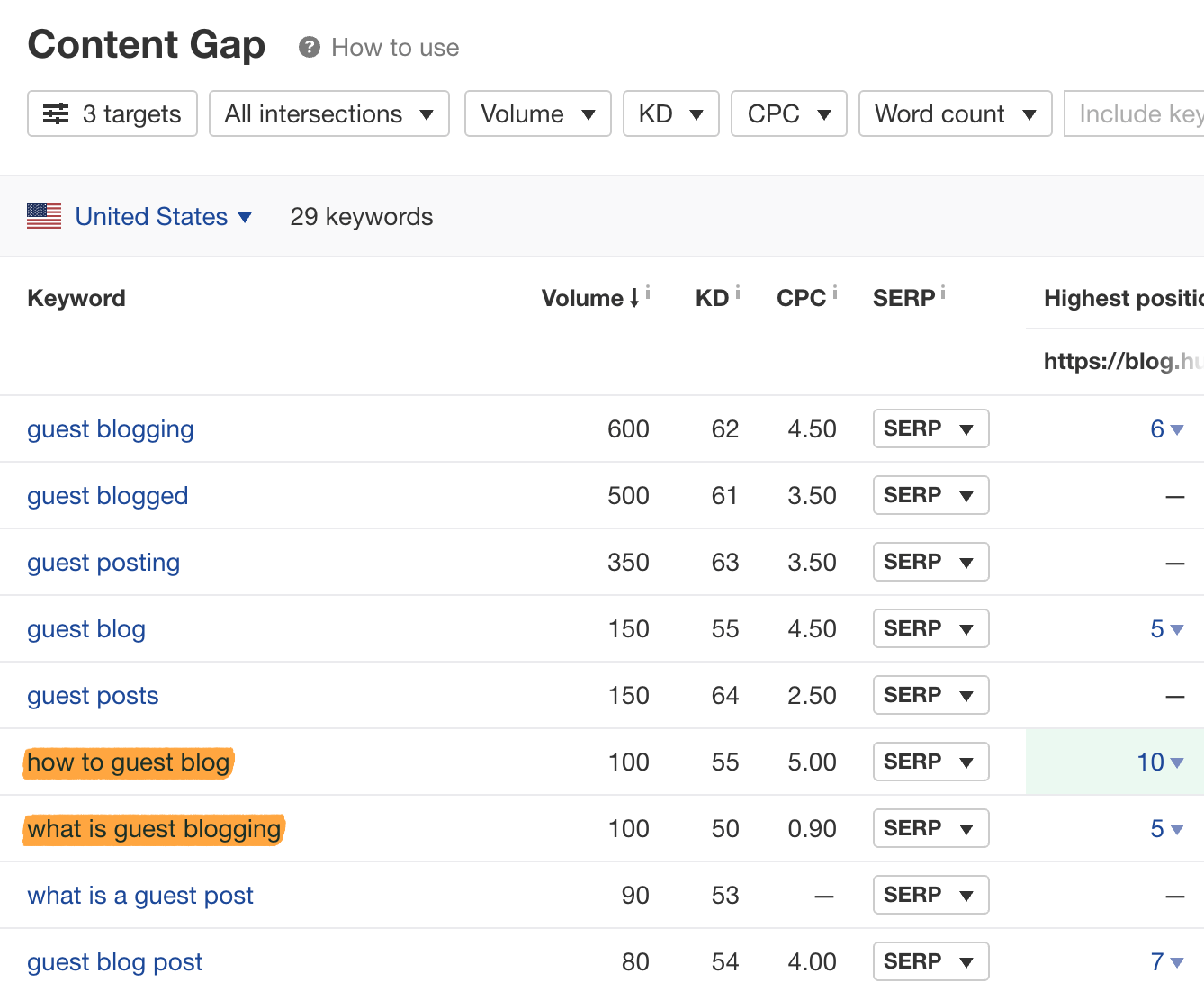
Photo: Ahrefs
You don’t need to assess ranking difficulty for these subtopics; just add new sections to your existing page to fill the gaps.
Final thoughts
It’s not a bad idea to repeat the keyword competitive analysis process from time to time. It’s a fantastic way to find topics that you might have missed.
Alternatively, once you know your competitors, you can set up keyword alerts to keep tabs on new keywords they’re ranking for—and possibly targeting. To do this, set up a new keywords alert in Ahrefs Alerts. Enter a competitor, select a country, choose the search volume range and alert frequency, and you’re off to the races.
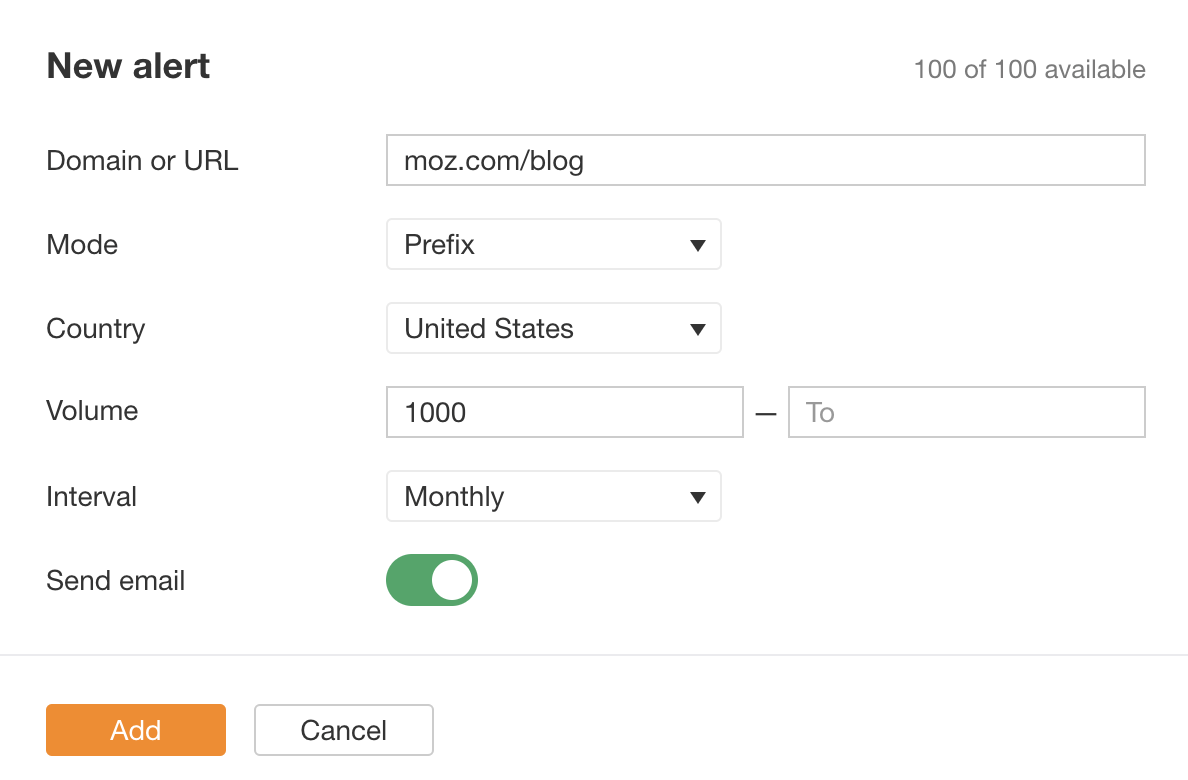 Photo: Ahrefs
Photo: Ahrefs
Monitoring new keyword rankings for one of our competitors in Ahrefs Alerts.
Got questions? Ping me on Twitter.
Originally posted on Ahrefs.
